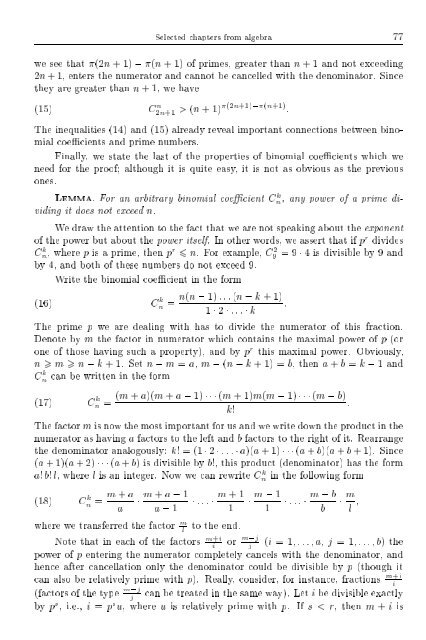SELECTED CHAPTERS FROM ALGEBRA I. R. Shafarevich Preface
SELECTED CHAPTERS FROM ALGEBRA I. R. Shafarevich Preface
SELECTED CHAPTERS FROM ALGEBRA I. R. Shafarevich Preface
You also want an ePaper? Increase the reach of your titles
YUMPU automatically turns print PDFs into web optimized ePapers that Google loves.
Selected chapters from algebra 77we see that (2n +1); (n + 1) of primes, greater than n + 1 and not exceeding2n +1, enters the numerator and cannot be cancelled with the denominator. Sincethey are greater than n +1,wehave(15) C n 2n+1 > (n +1)(2n+1);(n+1) :The inequalities (14) and (15) already reveal important connections between binomialcoecients and prime numbers.Finally, we state the last of the properties of binomial coecients which weneed for the proof although it is quite easy, it is not as obvious as the previousones.LEMMA. For an arbitrary binomial coecient Cn k , any power of a prime dividingit does not exceed n.We draw the attention to the fact that we are not speaking about the exponentof the power but about the power itself. In other words, we assert that if p r dividesCn k,wherep is a prime, then pr 6 n. For example, C9 2 =9 4 is divisible by 9andby 4, and both of these numbers do not exceed 9.Write the binomial coecient in the form(16) C k nn(n ; 1)...(n ; k +1)= :1 2 ... kThe prime p we are dealing with has to divide the numerator of this fraction.Denote by m the factor in numerator which contains the maximal power of p (orone of those having such a property), and by p r this maximal power. Obviously,n > m > n ; k +1. Set n ; m = a, m ; (n ; k +1)=b, then a + b = k ; 1andC k n can be written in the form(17) C k n =(m + a)(m + a ; 1) (m +1)m(m ; 1) (m ; b):k!The factor m is now the most important for us and we write down the product in thenumerator as having a factors to the left and b factors to the right of it. Rearrangethe denominator analogously: k! =(1 2 ... a)(a +1)(a + b)(a + b +1). Since(a +1)(a +2)(a + b) is divisible by b!, this product (denominator) has the forma! b! l, wherel is an integer. Now we can rewrite Cn k in the following form(18) C k n = m + aa m + a ; 1a ; 1 ... m +11where we transferred the factor m lNote that in each ofthe factors m+iito the end.or m;jj m ; 11 ... m ; bb m l (i =1 ...a, j =1 ...b)thepower of p entering the numerator completely cancels with the denominator, andhence after cancellation only the denominator could be divisible by p (though itcan also be relatively prime with p). Really, consider, for instance, fractions m+ii(factors of the type m;jjcan be treated in the same way). Let i be divisible exactlyby p s , i.e., i = p s u, where u is relatively prime with p. If s < r, then m + i is
















